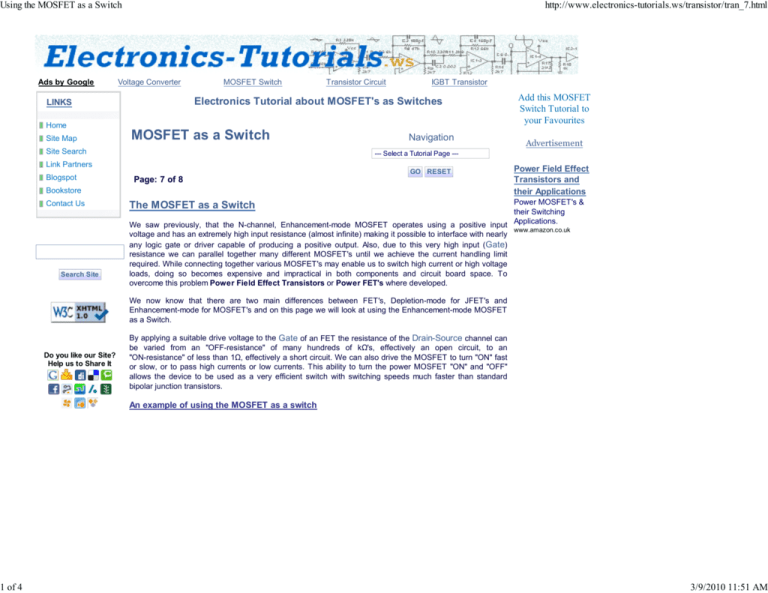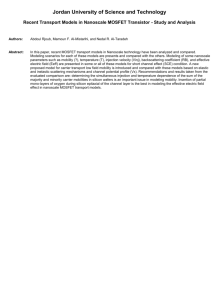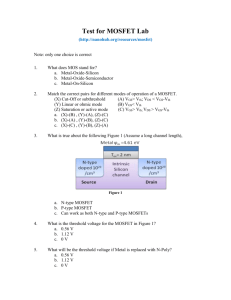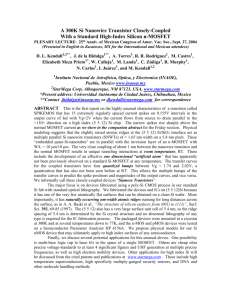
Using the MOSFET as a Switch
1 of 4
Ads by Google
http://www.electronics-tutorials.ws/transistor/tran_7.html
Voltage Converter
MOSFET Switch
Transistor Circuit
IGBT Transistor
Electronics Tutorial about MOSFET's as Switches
LINKS
Home
Site Map
MOSFET as a Switch
Site Search
Navigation
GO RESET
Page: 7 of 8
Bookstore
Contact Us
Search Site
Advertisement
--- Select a Tutorial Page ---
Link Partners
Blogspot
Add this MOSFET
Switch Tutorial to
your Favourites
Power Field Effect
Transistors and
their Applications
Power MOSFET's &
their Switching
We saw previously, that the N-channel, Enhancement-mode MOSFET operates using a positive input Applications.
www.amazon.co.uk
voltage and has an extremely high input resistance (almost infinite) making it possible to interface with nearly
any logic gate or driver capable of producing a positive output. Also, due to this very high input (Gate)
resistance we can parallel together many different MOSFET's until we achieve the current handling limit
required. While connecting together various MOSFET's may enable us to switch high current or high voltage
loads, doing so becomes expensive and impractical in both components and circuit board space. To
overcome this problem Power Field Effect Transistors or Power FET's where developed.
The MOSFET as a Switch
We now know that there are two main differences between FET's, Depletion-mode for JFET's and
Enhancement-mode for MOSFET's and on this page we will look at using the Enhancement-mode MOSFET
as a Switch.
Do you like our Site?
Help us to Share It
By applying a suitable drive voltage to the Gate of an FET the resistance of the Drain-Source channel can
be varied from an "OFF-resistance" of many hundreds of kΩ's, effectively an open circuit, to an
"ON-resistance" of less than 1Ω, effectively a short circuit. We can also drive the MOSFET to turn "ON" fast
or slow, or to pass high currents or low currents. This ability to turn the power MOSFET "ON" and "OFF"
allows the device to be used as a very efficient switch with switching speeds much faster than standard
bipolar junction transistors.
An example of using the MOSFET as a switch
3/9/2010 11:51 AM
Using the MOSFET as a Switch
2 of 4
http://www.electronics-tutorials.ws/transistor/tran_7.html
In this circuit arrangement an Enhancement-mode
N-channel MOSFET is being used to switch a
simple lamp "ON" and "OFF" (could also be an
LED). The gate input voltage VGS is taken to an
appropriate positive voltage level to turn the
device and the lamp either fully "ON", (VGS =
+ve) or a zero voltage level to turn the device fully
"OFF", (VGS = 0).
If the resistive load of the lamp was to be replaced
by an inductive load such as a coil or solenoid, a
"Flywheel" diode would be required in parallel with
the load to protect the MOSFET from any
back-emf.
Electrical
Software
EasyPower
Design Software
Fastest, Easiest,
& Most Accurate
www.easypower.com
Panasonic
PhotoMOS
Relays
Low
On-Resistance,
Long Life, Fast
Switching Speed,
Small Size
pewa.panasonic.com/pcs
Digi-Key
Rated #1 for
Overall
Performance 18
Years in a Row.
Same Day
Shipping.
www.digikey.com
Motion, Pro-Dex
OMS
Pro-Dex OMS
motion controllers
for Ethernet,
USB, RS232,
VME & PCI bus
www.Pro-DexOMS.com
Above shows a very simple circuit for switching a resistive load such as a lamp or LED. But when using
power MOSFET's to switch either inductive or capacitive loads some form of protection is required to prevent
the MOSFET device from becoming damaged. Driving an inductive load has the opposite effect from driving
a capacitive load. For example, a capacitor without an electrical charge is a short circuit, resulting in a high
"inrush" of current and when we remove the voltage from an inductive load we have a large reverse voltage
build up as the magnetic field collapses, resulting in an induced back-emf in the windings of the inductor.
For the power MOSFET to operate as an analogue switching device, it needs to be switched between its
"Cut-off Region" where VGS = 0 and its "Saturation Region" where VGS(on) = +ve. The power dissipated in
the MOSFET (PD) depends upon the current flowing through the channel ID at saturation and also the
"ON-resistance" of the channel given as RDS(on). For example.
Example No1
Semiconductors
Wholesale
Direct factory
price from China.
OEM Diode,
Power Device,
CustomMade
Lets assume that the lamp is rated at 6v, 24W and is fully "ON" and the standard MOSFET has a channel
"ON-resistance" ( RDS(on) ) value of 0.1ohms. Calculate the power dissipated in the MOSFET switch.
The current flowing through the lamp is calculated as:
www.mericatech.com
Then the power dissipated in the MOSFET will be given as:
You may think, well so what!, but when using the MOSFET as a switch to control DC motors or high inrush
current devices the "ON" channel resistance ( RDS(on) ) is very important. For example, MOSFET's that
control DC motors, are subjected to a high in-rush current as the motor first begins to rotate. Then a high
RDS(on) channel resistance value would simply result in large amounts of power being dissipated within the
MOSFET itself resulting in an excessive temperature rise, and which in turn could result in the MOSFET
3/9/2010 11:51 AM
Using the MOSFET as a Switch
3 of 4
http://www.electronics-tutorials.ws/transistor/tran_7.html
becoming very hot and damaged due to a thermal overload. But a low RDS(on) value on the other hand is
also desirable to help reduce the effective saturation voltage ( VDS(sat) = ID x RDS(on) ) across the
MOSFET. When using MOSFET´s or any type of Field Effect Transistor for that matter as a switching
device, it is always advisable to select ones that have a very low RDS(on) value or at least mount them onto a
suitable heatsink to help reduce any thermal runaway and damage.
Power MOSFET Motor Control
Because of the extremely high input or Gate resistance that the MOSFET has, its very fast switching speeds
and the ease at which they can be driven makes them ideal to interface with op-amps or standard logic
gates. However, care must be taken to ensure that the gate-source input voltage is correctly chosen
because when using the MOSFET as a switch the device must obtain a low RDS(on) channel resistance in
proportion to this input gate voltage. For example, do not apply a 12v signal if a 5v signal voltage is required.
Power MOSFET´s can be used to control the movement of DC motors or brushless stepper motors directly
from computer logic or Pulse-width Modulation (PWM) type controllers. As a DC motor offers high starting
torque and which is also proportional to the armature current, MOSFET switches along with a PWM can be
used as a very good speed controller that would provide smooth and quiet motor operation.
Simple Power MOSFET Motor Controller
As the motor load is inductive, a simple "Freewheeling" diode is connected across the load to
dissipate any back emf generated by the motor
when the MOSFET turns it "OFF".
The Zener diode is used to prevent excessive
gate-source input voltages.
Semiconductors Wholesale
ROHM Switching regulator
Direct factory price from China. OEM Diode,
Power Device, CustomMade
Efficient, with pulse skip control system.
Offered in various outputs.
Goto Page: 1 2 3 4 5 6 7 8
3/9/2010 11:51 AM
Using the MOSFET as a Switch
4 of 4
http://www.electronics-tutorials.ws/transistor/tran_7.html
External Links about using the MOSFET as a Switch
MOSFET Switch Drivers - Good Tutorial Explaining how to use the MOSFET as a Switch.
Purdue University
IGFET´s - pdf File Explaining how to use and Connect IGFET´s.
Socratic Electronics
Using a MOSFET as a Switch - Tutorial about using a MOSFET as a Switch.
Burning Software
MOSFET´s and their Applications - Introduction to Power MOSFET's and their Applications.
National Semiconductor
Link to us :
http://www.electronics-tutorials.ws/transistor/tran_7.html
Page Designed and Written by Wayne Storr. Last updated March 2010 ,
Copyright © 1998 − 2010, Electronics-Tutorials.ws, All Right Reserved.
3/9/2010 11:51 AM







